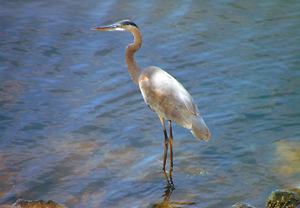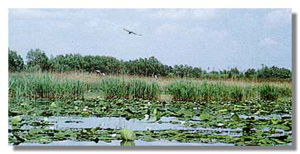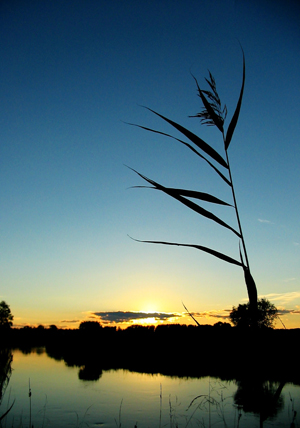Men, Land and Water
by Paola Emilia Rubbi
The long thred of history.
The oases of Vallesanta and Campotto in Argenta represent 850
hectares of free, uncontaminated nature where grow a wide variety of vegetal and
animal species (many of which are quite rare in the national panorama); where
herons, egrets, shanks, cormorants and other bird species (of which 145 are
migrators) live peacefully and often nidify
Vallesanta and Campotto in Argenta represent 850
hectares of free, uncontaminated nature where grow a wide variety of vegetal and
animal species (many of which are quite rare in the national panorama); where
herons, egrets, shanks, cormorants and other bird species (of which 145 are
migrators) live peacefully and often nidify ; where you can walk in valleys and marshes,
through the woods, pine forests, reeds, or in the countryside where every season
has different colours and the sounds the various animals make offer a different
atmosphere.
; where you can walk in valleys and marshes,
through the woods, pine forests, reeds, or in the countryside where every season
has different colours and the sounds the various animals make offer a different
atmosphere.
This is where it seems we still can hear the voices and songs of
the scariolanti, those very hard-working men who, with their simple
and important work a century ago, have changed this unrepeatable natural
environment. It was the work of man, in conjunction to drainage, that
transformed in natural oases of international interest these lands that were
once swampy, unhealthy and invisible.
"In this vast area, underlines Adamo
Antonellini, Councillor of the Commune of Argenta, the natural environment and
the work of man are weaving the elements allowing to go through the whole
history of this territory. We recall on one hand, the original environment
and, on the other hand, the long journey
of cultural and social growth, providing a wide thematic horizon, probably
unique in Europe, between nature, history, culture, economy, technology, water
and land."
the long journey
of cultural and social growth, providing a wide thematic horizon, probably
unique in Europe, between nature, history, culture, economy, technology, water
and land."
As a matter of fact, Vallesanta and Campotto are what is left of
the wide swamps which began to form from the twelfth century when the Po di
Primaro, then encumbered with sediments, could no longer receive the water
coming from the various streams of the Appennines. Overflowing, the waters then
formed a large wetland which remained so until the  beginning of
the 900s. This marks the beginning of the "great adventure" of drainage with the
development of an articulated system made of 850 hectares of enormous basins of
land into which water flows and is accumulated when the Reno is no longer able
to take it. It put in place the conditions for the development and survival of a
true nature, luxuriant and hospitable for all living species while creating a
system of defense of the territory whether it is for an excess or a lack of
water.
beginning of
the 900s. This marks the beginning of the "great adventure" of drainage with the
development of an articulated system made of 850 hectares of enormous basins of
land into which water flows and is accumulated when the Reno is no longer able
to take it. It put in place the conditions for the development and survival of a
true nature, luxuriant and hospitable for all living species while creating a
system of defense of the territory whether it is for an excess or a lack of
water.
It is here, in Saiarino, that it is possible to see the gigantic
water-scooping pumps (fabricated more than a century ago and still in working
condition) with which the water in the bassins during spates was flowed into the
Reno and discharged for the fields' irrigation.
The Consorzio della Bonifica
Renana was a consortium that managed this complex hydraulic system of water
regulation, its beating heart being in Saiarino and in the oases of Campotto and
Vallesanta constituting what little remains of a landscape once much more
expanded : Padusa.
A few kilometers from Bologna, less still from Ferrara, it
is in a unique natural habitat, today preserved thanks to a delicate and vital
hydraulic stability ensured, once again, by the work of man.
The millenary
interaction between man and the land, witnessed by the valleys, is richly and
precisely documented in these three museums: delle Valli, dela Bonifica and
Civico. We are in the middle of the Ecomuseum of Argenta which in turn is part
of the Parc of the Delta of the Po.
Walking around these oases or stoping at
one of the observatories of reeds that were built here and there, it is possible
to see the flight of a Great Crested Grebe, a Whooper Swan, a Common Mallard, a
Ferruginous Duck, a Whiskered Tern, or it is possible to observe - in the green
waters - thousand species of waterlilies or the aquatic gentian, and in the
grass-dominated meadows, the levees and the reeds: the water speedwell, the
water mint, the marsh spurge, the yellow iris... and it is the museum centres
that can be found the technique and human activity: the water-scooping
installations with their intact mechanisms; the old ovens for the use of the
thermic central; the transformers, the immense interrupters; the large
reproduction of a flood with the water courses getting larger and the
water-scooping pumps working at full capacity. Pictures of the period and
illustrative panels sort out the long thred of the weaved history of men, land
and water.